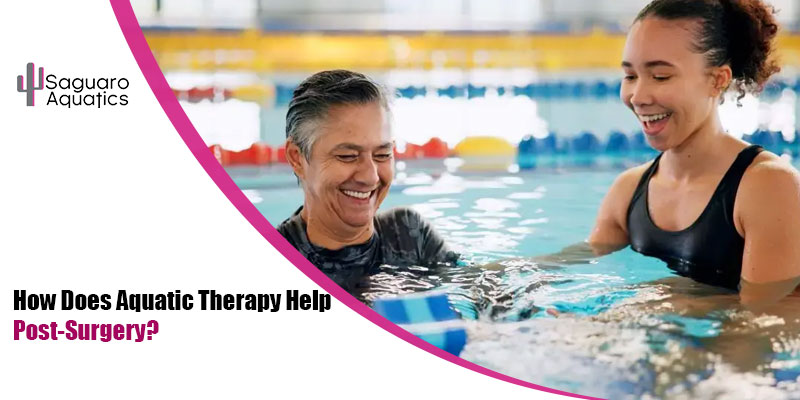After surgery, resting is not the only thing that can help with active healing in you. For many, healing after surgery can be just as traumatic as challenging, as it can cause pain and stiffness, and worst of all, a mindset that you might get hurt again. This is where post-surgery aquatic therapy comes in. Aquatic therapy, or water physical therapy, or hydrotherapy, provides relief by using the natural properties of water, like its buoyancy, resistance, and warmth. This helps create a healing environment whether you’re recovering from a joint replacement, spinal surgery, or sports injury operation. When searching for water physical therapy near me, consider water-based rehab, which is highly effective and can accelerate healing while minimizing discomfort for both children and adults.
In today’s blog, we’ll explore the benefits of hydrotherapy, how it helps with healing, and outline a week-by-week recovery plan from Saguaro Aquatics. We’ll answer all your questions, so keep reading till the end.
What makes water therapy ideal for post-surgery recovery?
Being in the water is fun; however, it’s also one of the best ways to heal your body. Here are the reasons why hydrotherapy is best for people dealing with post-surgery pain:
- Buoyancy Reduces Stress on Joints
Water supports up to 90% of your body weight, so it puts less pressure on your joints, bones, and surgical sites.
- Resistance Builds Strength Safely
It offers natural resistance in all directions that helps you improve your overall muscle tone without using heavy weights.
- Warmth Increases Blood Flow
When you take warm water therapy, it relaxes muscles and boosts circulation, speeding up healing and reducing stiffness.
- Improves Range of Motion
The fluid environment in the pool allows you to move freely without having to restrict your movements, which aids full-body flexibility.
- Reduces Swelling and Pain
The Hydrostatic pressure, or the pressure from water, reduces inflammation around surgical areas, giving you long-lasting relief.
-
Boosts Confidence and Mental Wellbeing
Finally, it provides quick recovery in water, which can reduce anxiety and improve your motivation to move around without worrying about getting hurt again.
Who can benefit from Hydrotherapy post-surgery?
If you or your loved ones have had the following, they will benefit from Saguaro Aquatic’s water therapy:
- Knee, Hip, or Shoulder Joint Replacement
- Spinal Surgery
- Fracture Surgery
- Arthroscopic Surgery
- Sports Injury Repairs like ACL, Meniscus, and Rotator Cuff
- Soft tissue reconstructions
Post-Surgery Water Therapy: A Week-by-Week Recovery Plan
Every patient is different; that’s why we offer plans that are often customised and created by experts. Here is a general 8-week plan we follow:
Week 1-2: Gentle Introduction to Immersion and Movement
The goal is to:
- Reduce your pain and swelling.
- Begin basic movement under the water.
- And, build trust in movement.
Common Activities:
- You will be water walking with support
- Perform gentle leg and arm lifts
- Do deep breathing exercises
- And, water floating for muscle relaxation
Week 3-4: Strength and flexibility
The goal is to:
- Improve your overall body balance and coordination
- Focus on building endurance
- And, activate the surrounding muscles
Common Activities:
- You will perform backward walking and side steps
- Do arm circles and wall push-offs
- Underwater seated leg presses
- And finally, gentle stretching, including your hamstrings and shoulders
Week 5-6: Functional Training
The goal is to:
- Improve your joint range
- Stimulate daily movements
- And, strengthen muscles
Common activities:
- You will perform cross-body arm pulls
- Lift leg with ankle weights
- Step-ups on water submerged stairs
- And, finally, underwater squats
Week 7-8: Back to land-based movements
The goal is to:
- Prepare your body for off-water rehab
- Build muscle tone and focus on your stamina
- And, improve your body’s full range of motion
Dos and Don’ts of Aquatic Therapy After Surgery
Even under professional supervision, follow these dos and don’ts for a healthy recovery post-surgery:
Dos
- Consult with Your Doctor or Surgeon First
Before you start aquatic therapy, always get medical clearance. Some surgeries or healing stages may require you to wait until your wound is closed and swelling is reduced. Not following the proper timeline can worsen your overall body situation.
- Work with a Certified Aquatic Therapist
Always choose an Aquatic therapy like Saguaro Aquatics, as you should be guided by a trained professional who knows your surgery type and recovery goals. They will monitor your form, pace, and limitations safely, for your health and comfort.
- Use Pool Equipment for Support and Safety
Always use aquatic tools like flotation belts, pool noodles, foam dumbbells, and water shoes to provide extra balance, resistance, and grip. This will make your aquatic therapy safer and more effective.
- Focus on Controlled, Gentle Movements
Water makes movement smoother, but you still need to move mindfully and focus on each movement slowly to engage muscles properly. This will also help you avoid unnecessary stress on your surgical area.
- Choose Therapeutic Temperature Pool
Make sure to choose warm water, as it soothes muscles, increases circulation, and eases stiffness. When you do so, you get a comfortable pool temperature, which is key to both safety and effectiveness.
- Hydrate Before and After Each Session
Even though you’re in water, your body still loses fluids through sweat and exertion. So, make sure to drink enough water to stay hydrated. This will also aid your quick recovery.
- Start Small and Build Gradually
Don’t rush and always start with basic range-of-motion exercises and low resistance. This will help your confidence and strength grow, and then your therapist will guide you to more functional movements.
- Listen to Your Body’s Signals
You may feel mild fatigue and soreness, which are normal. If you experience sharp pain, dizziness, or swelling after sessions, please stop and consult a healthcare professional. These are warning signs that something is not right, and you should consult your aquatic and general therapists.
(Also read from our previous blogs: Effective Arthritis Pain Management Through Water Therapy)
- Practice Deep Breathing and Relaxation
It will help you relax and focus, especially during early recovery when fear of movement is high. Breathing will also actively support muscle coordination and core control.
- Be Consistent
And finally, be consistent. Track your progress in aquatic therapy, even if it’s in a gradual stage, and aim for 2-3 sessions a week as advised by your therapist. This will help you recover naturally and quickly.
Don’ts
- Don’t Get in the Pool with Open Wounds
Don’t get in the pool if you have open incisions or uncovered surgical sites. You can get infected and infect your fellow healers. So it’s best to wait until your wound is entirely closed or waterproofed before starting therapy. Talk to your therapist for more advice.
- Don’t Self-Treat Without Guidance
Although water feels easy, exercising without supervision can slow down healing or, worse, cause an injury. That’s why it’s always best to follow a therapist’s personalized plan.
- Don’t Rush or Overdo Movements
Don’t go too fast or do high-intensity exercises, as it can backfire and cause injuries instead of healing you. Remember, the healing tissues are sensitive, and overexertion can set you back. It will cause more pain and delay healing.
- Don’t Skip Warm-Up and Cool-Down
Your body still needs to transition in and out of activity. So always do the basic stretching and gentle movements before and after to prevent muscle tension and soreness.
- Don’t Use Cold Pools for Rehabilitation
We don’t recommend cold pools, even though they feel refreshing. Freezing water can constrict circulation and reduce flexibility. So stick to warm pools in general.
- Don’t Hold Your Breath
Finally, avoid holding your breath while exercising, as it can increase tension and reduce oxygen flow. Instead, practice steady, rhythmic breathing during movements to improve your endurance.
Bottom Line
Undoubtedly, when in Tucson, you do not need to worry and look around for professional water physical therapy near me. Instead, simply visit Saguaro Aquatic’s official page or give us a call to get in touch with our experts. We focus on your health and provide safe healing post-surgery.
So, do not wait in agony anymore. Get in touch with our experts today. You can contact us here or email us at: swim@saguaroaquatics.com





